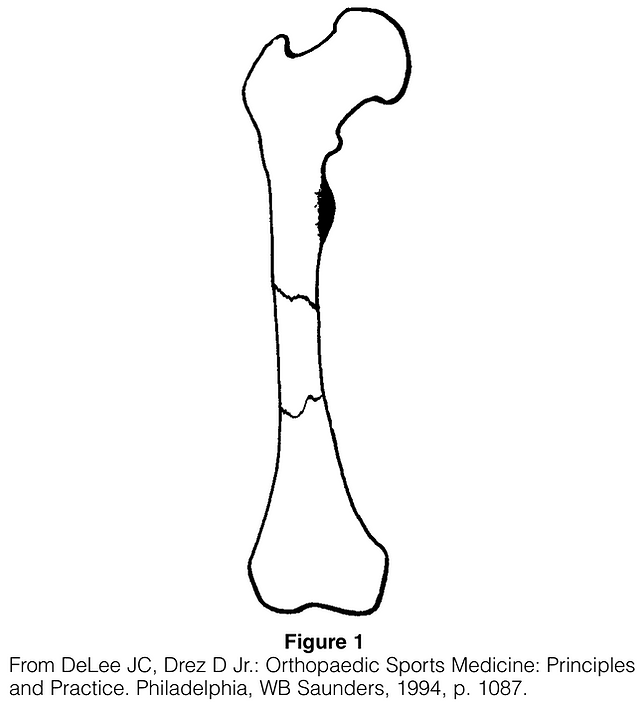Femoral Shaft Stress Fracture
■ ■ ■ Description
A femoral shaft stress fracture is a complete or incomplete break in the long part of the thigh bone (femur) caused by intense exercise or repetitive pressure on the extremity. The wear and injury in the bone exceeds the bone’s ability to heal and repair the injury, resulting in a breakdown of the bone, causing a stress or fatigue fracture. This is the fourth most common stress fracture.
■ ■ ■ Common Signs and Symptoms
-
Vague, diffuse pain or ache and occasionally tenderness and swelling in the thigh or groin
-
Uncommonly, bleeding and bruising in the thigh
-
Weakness and inability to bear weight on the injured extremity
-
Paleness and deformity (sometimes)
■ ■ ■ Causes
Femoral shaft stress fractures are caused by repetitive force greater than the bone can withstand. This may occur when there is an imbalance between bone injury and bone remodel- ing (healing) and usually follows a change in training or performance schedule, equipment, or intensity of activity. It is also associated with a bone’s ability to heal and may be impaired when there is a loss of menstrual period in women.
■ ■ ■ Risk Increases With
-
Previous stress fracture
-
Military recruits and distance runners
-
Bony abnormalities (including osteoporosis and bone tumors)
-
Metabolic disorders, hormone problems, and nutritional deficiencies and disorders (anorexia or bulimia)
-
Loss of or irregular menstrual periods
-
Poor physical conditioning (strength and flexibility)
-
Sudden increase in the duration, intensity, or frequency of physical activity
■ ■ ■ Preventive Measures
-
Appropriately warm up and stretch before practice or competition.
-
Maintain appropriate conditioning:
-
Muscle strength
-
Endurance and flexibility
-
Cardiovascular fitness
-
-
Wear proper footwear, including changing shoes after 300 to 500 miles of running.
-
Use proper technique with training and activity.
-
Gradually increase activity and training.
-
For women with menstrual period irregularity, treat hormonal disorders, such as with birth control pills.
-
Correct metabolic and nutritional disorders.
-
For runners with flat feet, wear cushioned arch supports.
■ ■ ■ Expected Outcome
This condition is usually curable with appropriate treatment within 6 to 8 weeks.
■ ■ ■ Possible Complications
-
Failure to heal (nonunion)
-
Healing in poor position (malunion)
-
Recurrence of stress fracture
-
Stress fracture progressing to a complete and displaced fracture
-
Risks of surgery, including infection, bleeding, injury to nerves (numbness, weakness, paralysis), and need for further surgery
-
Recurrence of stress fractures, not necessarily in the same bone or location (occurs in 1 in 10 patients)
■ ■ ■ General Treatment Considerations
Initial treatment consists of medications and ice to relieve pain, relative rest from the activity that caused the fracture. Occasionally crutches may be recommended to protect the bone while it heals. Menstrual, nutritional and metabolic abnormalities need to be identified and treated appropriately to help healing and prevent recurrence. After rest, gradual return to activity is recommended. Uncommonly, bone stimulators which provide electrical currents to the bone may be attempted. Rarely surgery is necessary. Physical therapy may be helpful in gradually increasing strength of the muscles and bones after stress fracture and/or maintain cardiovascular fitness while awaiting the bone to heal.
■ ■ ■ Medication
-
Nonsteroidal anti-inflammatory medications, such as aspirin and ibuprofen (do not take within 7 days before surgery), or other minor pain relievers, such as acetaminophen, are often recommended. Take these as directed by your physician. Contact your physician immediately if any bleeding, stomach upset, or signs of an allergic reaction occur.
-
Topical ointments may be of benefit.
-
Narcotic pain relievers may be prescribed by your physician for severe pain. Use only as directed.
■ ■ ■ Notify Our Office If
-
Symptoms get worse or do not improve in 2 weeks despite treatment
-
The following occur after immobilization or surgery (report any of these signs immediately):
-
Swelling above or below the fracture site
-
Severe, persistent pain
-
Blue or gray skin below the fracture site, especially under the nails, or numbness or loss of feeling below the fracture site
-
-
New, unexplained symptoms develop (drugs used in treatment may produce side effects)

View as PDF